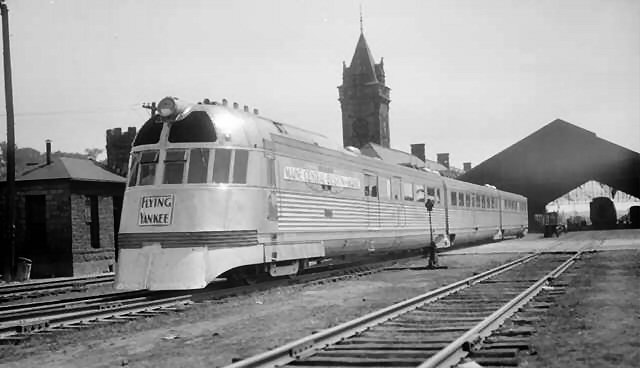- Flying Yankee
Infobox Locomotive
name = Flying Yankee
powertype = Diesel

imagesize = 250
caption =The "Flying Yankee" atPortland, Maine in 1937.
builder =Budd Company and Electro-Motive Division
buildmodel = BM-MEC 6000
builddate = 1935
totalproduction = 1
aarwheels = B-B-B
gauge = RailGauge|sg
bogies =Jacobs Bogie
primemover = Winton 201-A
enginetype = Diesel
cylindercount = 8
railroad =Maine Central Railroad
locale =North America
deliverydate = February 1935
lastrundate =May 7 ,1957
restoredate = On going project
currentowner =State of New Hampshire
disposition = Under restorationThe "Flying Yankee" was a diesel-poweredstreamliner built in 1935 for theMaine Central Railroad andBoston and Maine Corporation byBudd Company and with mechanical and electrical equipment from General Motors Electro-Motive Division. It was the third streamliner train inNorth America after theUnion Pacific Railroad 'sM-10000 and theChicago, Burlington and Quincy Railroad 's "Pioneer Zephyr "; the "Flying Yankee" was, in fact, a virtual clone of the latter, except that it dispensed with the baggage/mail space to seat 142 in three articulated cars.The lightweight train was constructed with welded
stainless steel using Budd's patented process. The engine was an 8-cylinder Winton 201-A diesel, driving a generator; the lead truck was equipped with traction motors. It was fitted with air conditioning in all cars. No dining car was provided; instead, meals were prepared in a galley and served to passengers in trays that clipped to the back of the seat in front.The train was delivered in February 1935, and toured the BM-MEC railroad system before entering service on
April 1 . The daily route served began inPortland, Maine , then toBoston, Massachusetts , followed by a return to Portland and continuing toBangor, Maine , returning through Portland to Boston and finally returning to Portland late in the day, a distance of 750 miles per day. This schedule was kept six days a week; the trainset spent Sundays undergoing maintenance. The train proved extremely successful, attracting new ridership and earning a profit for its owners.Later on, as newer equipment replaced it on one route, it would be switched to other routes, bearing the names "The Cheshire", "The Minuteman", and "The Business Man".
As railroad passenger ridership declined in the 1950s the Yankee was also getting old, and thus the trainset was retired, running its last on
May 7 ,1957 . The railroad donated the trainset to theEdaville Railroad tourist / museum operation inCarver, Massachusetts . The train remained on static display there for about 40 years until it was moved in the early 1990s to Glen, a village ofBartlett, New Hampshire after being purchased by the late Bob Morrell, former owner ofStory Land .In 1997, the train was moved to the Claremont Concord Railroad's shops in
Claremont, New Hampshire for a complete restoration once purchased by the State of New Hampshire, which is presently ongoing.As of 2004 , the major structural restoration has been completed, and detailed restoration of components is proceeding. The eventual goal is to restore the train completely to running condition. The train was moved toLincoln, New Hampshire , onAugust 10 2005 , to theHobo Railroad where the mechanical restoration is taking place.References
* Colquhoun, Lorna, New Hampshire Union Leader (
August 11 2005 ), " [http://www.theunionleader.com/articles_showa.html?article=58957 Flying Yankee rolls into Hobo Railroad] ". RetrievedAugust 11 2005 .
* Lindblade, Carl E. and The Flying Yankee Restoration Group. "The Story of the Flying Yankee". Retrieved from http://www.flyingyankee.com/history.html onDecember 19 ,2004
*External links
* [http://www.flyingyankee.com/ The Flying Yankee Restoration Group] - The organization that is undertaking the train's complete restoration.
Wikimedia Foundation. 2010.
